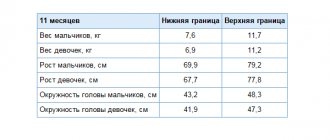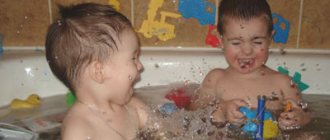Number of views: 78,737
A parent is a person whose life is full of surprises and stressful situations. The statement that surprises do not await responsible parents is fundamentally wrong. Anything can happen, but the consequences of the situation largely depend on mother’s actions. The baby takes water procedures from the first days of life. As soon as the mother turns away, the child has swallowed water , the consequences can be any. He can dive and drink water in a baby bath, inflatable pool or in a natural body of water. In most cases, tragedy does not happen, but it is important to know how to act in such a case.
A child swallowed water while bathing: is it dangerous?
Even when bathing in a bath under the supervision of parents, the baby may suddenly go under water and swallow soapy dirty water due to pranks. If after surfacing he begins to cough heavily, there is no need to prevent this conditioned reflex action . The human body is equipped with reliable systems of protection against various hazards, including those associated with water and its aspiration (swallowing) into the respiratory tract. The brain automatically turns on defense mechanisms against the spread of fluid in the lungs, triggering a strong cough and expelling fluid particles out.
Coughing due to forced exhalations and contraction of the muscles of the bronchial tree makes it possible to quickly remove remaining fluid out. After this, you need to take the child out of the water and wrap him in a warm large towel, dry the skin and hug him tenderly to calm him down and let him know that nothing bad happened. Usually, home aspirations of water in the bathtub are not dangerous by accident; just a couple of sips of water get in, which are not life-threatening. But if the parents left the child alone in the bathroom and did not see the moment of going under water, they cannot estimate the duration of the baby’s stay under water, they must immediately after providing first aid, call an ambulance and take the child to the hospital. It is especially dangerous if the baby has swallowed water, he is pale, breathes weakly and does not cough. Then, along with calling an ambulance, you need to begin immediately providing emergency measures.
Important
When providing assistance, there is no place for panic! It is important to remain as calm as possible and act clearly. Any negative emotions and excitement can be transmitted to the baby; he may subsequently develop a phobia of water, which will complicate the life of parents.
Seven-month-old baby choked while bathing at home
As MK learned, the accident occurred on February 10 in an apartment in one of the high-rise buildings in the southeast of the capital. During the day, 29-year-old native of Central Asia Azgul (all names have been changed) was at home with five minor children. The woman asked her eldest daughter to help bathe her little brother. She turned on the water, put the baby in the bath and left. The girl closed the drain hole and then got distracted, leaving her brother unattended. The schoolgirl didn’t even notice how the boy fell and choked on water. When, after some time, the mother looked into the bathroom, the child no longer showed signs of life. Frightened, she began to call her husband. The man immediately rushed home from work. According to him, on the way he tried to call the ambulance, but was unable to do so. When he got home, he grabbed his son and drove to the nearest children's clinic. However, it was already too late; the doctors could not save the child.
Unfortunately, this is by no means an isolated case of this kind. Adults leave children alone with danger, leaving “for a minute.” But sometimes this time is enough. How can you still prevent a tragedy if the baby has already swallowed water? Anton Korenevsky, a first aid instructor at one of the training centers, to answer this question .
— One of the most common mistakes is when parents grab the baby and start shaking him upside down. This is completely pointless. The child may even begin to have fluid coming out of his mouth, but this is water that has entered the stomach. It does not interfere with breathing. And it is necessary to get rid of the fluid in the lungs. The first thing adults should do in such a situation is to assess the baby’s condition, to understand whether he is breathing and whether he is conscious. It is enough to check the pain syndrome with light blows on the heels; the child, with preserved consciousness, will begin to pull his leg away. If, nevertheless, the baby does not breathe and does not respond, you should immediately call an ambulance and begin resuscitation efforts. Just be sure to take into account the fact that this is a child, not an adult. Indirect cardiac massage for children under one year old is enough to be performed with finger pressure, for older children - with one hand. The ratio is the same as for an adult: 30 compressions - 2 breaths. When it comes to helping children, emergency services arrive as quickly as possible, but sometimes a few seconds can be decisive. Therefore, it is better for parents, and simply all people, to acquire a wealth of knowledge on the correct provision of first aid.
Dry drowning: first aid
In addition to water entering the lungs and developing the usual signs of drowning, in rare cases a delayed complication may occur - the so-called dry drowning. This pathology is extremely rare among children, so there is no need to panic about swallowing small volumes of water. Typically, children's protective reflexes are actively triggered. Cases of dry drowning are possible with a frequency of one in a million, but their signs are worth knowing for general information. The problem is that the signs of this type of drowning are very difficult to distinguish from secondary complications.
If a child, after falling under water and inhaling a certain volume of water, comes out and coughs, this does not mean that all possible risks have completely passed. It is important to monitor the baby for three days; during this period, signs of negative reactions to water entering the bronchi and lungs may occur. If we follow the classic definition of drowning, it is death from asphyxia (suffocation) that occurs when inhaling water and filling the lungs with it, which significantly suppresses their effective work in delivering oxygen to the tissues or completely prevents breathing. In case of secondary drowning, a person does not inhale water, and the lungs do not fill with it, and problems arise later, due to spasm of the bronchi and swelling of the pulmonary fields associated with the reaction to water in the lungs, which sharply reduces the ability of their work to carry out breathing or the respiratory system is completely suppressed function.
note
It is important to carefully monitor the child’s condition after leaving the water so that he feels good and breathes fully. If symptoms such as nausea, lethargy and drowsiness, malaise or faintness occur, you should immediately call a doctor.
First aid for children in case of drowning
The happiest time for children is, of course, the summer holidays! Textbooks are on the shelves, lessons and difficult assignments are behind us, and carefree time, communication with friends and summer fun are ahead! And there is nothing better than going to the beach in the hot summer: sunbathing, playing ball and swimming in the river. But everything is so good only in words; it is no secret that water poses a great danger to small children and teenagers. Most children often do not know how to swim and can drown even where it is not deep. That is why they should never be left unattended near bodies of water. Few children know how to hold their breath for a long time, and in shock situations they get scared, start crying and open their mouths wide. As a result, the liquid enters the respiratory tract in a split second and the child chokes on water and dies. Over the past week, the ambulance phone received 3 calls about children drowning. All cases ended in tragedy - the boys could not be saved. Of course, minors should not be left alone near rivers and reservoirs. Remember that inflatable rings, life jackets and other products, which, although designed to prevent disaster on the water, actually cannot completely protect the child. They may tear and deflate, or the baby may simply slip out of them. In the event that an accident does occur to a child, the outcome of such an incident depends, first of all, on the adult’s skills in providing first aid in case of drowning. How can you tell if a child is drowning? It is necessary to constantly pay attention to the posture and behavior of children in the water; when a child begins to drown, he most often cannot let anyone know that he is in trouble. Another sure sign that something is wrong with children is their noise. Children are never quiet on the water, and if they are quiet, something is wrong. Signs of drowning in children are similar to signs of a drowning adult: - the child’s head is thrown back and his mouth is open; - can swim face down; - suffocates; - tries to swim unsuccessfully, or, more simply, “floundering in the water.” If you notice at least one of these signs, you immediately need to come to the rescue and pull the child ashore as quickly as possible. But above all, ensure your own safety, since rescuing a drowning person is a very risky action for someone who is trying to be a rescuer. An unprepared person, without risk to himself, can help only in shallow water, in a children's pool, in a situation where he does not need to float on the water himself and swim somewhere. If you are not confident in your abilities, shout, call for help, but do not increase the number of drowning people with your enthusiasm! When rescuing a child, use available means (ropes, sticks, inflatable rings, etc.) and floating means (boats, etc.) whenever possible. A child pulled out of the water may be conscious, unconscious, in a state of stupor or lethargy. Changes in the pulse are also observed: it may become faster, slower, or absent. The heart works intermittently, it may stop. Breathing, if present, is shallow. Vomiting and coughing with foamy sputum are common. The stomach is swollen. The skin is pale, cold, with a bluish tint. After removing the victim from the water, you have only a few minutes to provide first aid to prevent irreversible changes in the organs and brain due to acute oxygen deficiency, since the brain can function for only 5-6 minutes without oxygen. And if first aid is not provided on time, death occurs. Resuscitation measures consist of three successive stages: ensuring airway patency, artificial respiration and cardiac massage. First aid for the drowning of a child has a clear standard algorithm for emergency actions that parents should know and includes the following measures: 1) call for help, ask to call an ambulance, 2) check whether the child is conscious. To do this, you need to lay the child on his back, on any hard surface, call the child by name and shake him by the shoulders; in infants, perform intense patting movements on the heel. If the child does not respond to your actions, it means that he is unconscious. 3) check if the child is breathing. To do this, you need to put one hand on the child's forehead, place one finger of the other hand on the chin and tilt his head back a little. Raise your chin, put your ear to the baby's mouth, watch his chest, and in this position, for no longer than 10 seconds, you should try to hear or feel the baby's breathing, notice the movement of his chest.
4) begin mouth-to-mouth artificial respiration if the child is not breathing. Artificial respiration should be like this: - tilt the child’s head back a little and lift his chin; - pinch the child’s nose with the hand that lies on the forehead; - open the child’s mouth slightly, keeping the chin in a raised position; - hold your breath and cover the child’s mouth with your lips; children under 1 year of age should cover both the nose and mouth with their lips at the same time; - Blow into the child’s mouth for 1-1.5 seconds, observing whether his chest rises; - the volume of inhaled air should not be greater than that which is stored in your mouth, since a larger volume of air can injure the child’s lungs; - keeping your head thrown back and your chin raised, release your baby’s mouth and watch how the air escapes from his chest; - repeat the entire procedure five times.
5) check the child’s heart function. To do this, you need to try to feel the pulse in the carotid arteries on the side of the neck for a few seconds, or with your ear attached to the child’s chest, hear the heartbeat.
6) start chest compressions if there are no signs of palpitations. Carrying out chest compressions: - kneel down in front of the child; - free your chest from clothing; - for older children: place the palm of one hand on the bottom of the sternum, and the palm of the other hand on top of it, - for younger children (1-5 years): along the longitudinal axis of the sternum, place the base of your right hand on the area where the ribs connect to the sternum - press on the body so that the chest drops three to four centimeters, since this is what provides the necessary stimulation of the heart, superficial pressure does not cause heart contractions, and excessive pressure leads to injury; - perform thirty rhythmic chest thrusts.
7) then follow the cycle - thirty techniques of indirect cardiac massage and two techniques of artificial respiration. In one minute it is necessary to carry out 100-120 compressions on the chest and 12-20 breaths until cardiac activity and breathing resume. After each minute of resuscitation, feel the pulse for several seconds. If there is no pulse, then cardiac massage and artificial respiration should be continued. If a pulse is felt, you need to check whether the child is breathing on his own. If the child is not breathing, continue artificial respiration, periodically checking the pulse and breathing. As soon as the child’s pulse and breathing are restored, activities are stopped, but the pulse and breathing are periodically checked until the ambulance arrives. It takes at least 40 minutes to resuscitate a child, especially after removing him from cold water, since a child’s body can survive up to 1 hour of clinical death in ice water without disturbances in the central nervous system. After breathing and pulse resume, you need to lay the child on his side and warm him up. Children who may have a suspected neck or spinal injury deserve special attention, which is often typical for children who jump into the water head first. When providing assistance to such a child, a number of points should be taken into account: you should not move the child unless absolutely necessary, and you should not place rolled up things under the head. The child’s head, body and neck should always be in the same plane; turning to one side is done by holding the head and neck so that the whole body turns over at the same time. Otherwise, spinal injury can only be aggravated. If the injured child has: consciousness, breathing, coughing, limb movements, vomiting, or they appeared during assistance: • give the child the opportunity to take the most comfortable position for him, or place him in a stable position on his side; • do not move away from the child and do not take your eyes off him: the condition may worsen and require assistance at any time; • remove wet clothes; • warm the child intensively - wrap him in dry warm clothes, blankets, if possible, take the child into a warm room or place him near a fire, use heating pads, fan heaters, etc.; • if the child is conscious, able to sit, and there is no vomiting, you need to give warm drinks in small sips - water, tea, compote, etc. Inflatable rings, life jackets and other products, which, although designed to prevent disaster on the water, actually cannot completely protect a child from drowning. They may tear and deflate, or the child may simply slip out of them.
Remember the following rules: • Teach children to swim. • Teach those who know how to swim to relax on the water. • Use the equipped beaches. • Any movement of a child towards water must be coordinated with adults. • Children should not be allowed to swim unsupervised, even if they know how to swim. • Strictly prohibit your child from diving if he does not know how to swim, or without first checking the depth of the reservoir and the condition of the bottom. • Do not allow children to swim far or cross bodies of water. • Strictly prohibit jumping into water in unfamiliar places and from cliffs. • A child who does not know how to swim should not go into the water without an inflatable vest (circle, sleeves) and further than waist-deep. • Great care must be taken when bathing children with inflatable mattresses, boats, rings. • A child in a boat must wear a life jacket. • Do not dive from or board boats and do not allow children to do so.
Signs of dry drowning
This term refers to health problems, including the death of a child, that occur within three days from the moment the liquid enters the water and is aspirated. Among the leading symptoms are severe difficulty breathing, changes in voice timbre, the formation of hoarseness, and hoarseness. There may be changes in mood or sudden changes in behavior, extreme fatigue, or sudden pain in the abdomen or chest. It is important to always control the child’s behavior in the water when swimming, so that the baby does not go under the water with his head and does not inhale.
What to do if a child swallows water?
If there is a suspicion that the child has inhaled under water and liquid has entered the respiratory tract, it is necessary to immediately remove the baby from the water, dry him and carefully examine him. It is necessary to monitor the breathing rate and its nature, and identify signs of possible dry drowning. Breathing after bathing should be free and silent, not difficult, without whistling or wheezing, which may indicate the presence of fluid in the bronchi.
If you suspect the presence of water in the bronchi and lungs, you need to immediately call an ambulance and hospitalize for treatment. To prevent drowning and complications from aspiration of fluid, you need to monitor the weather conditions when swimming, teach your child to swim and explain the rules of behavior in the water, and make sure that there are no dangerous games.
Child swallowed water - check breathing
The most difficult case is not breathing . In this case it is necessary:
- Perform artificial respiration and, if necessary, chest compressions
- Call an ambulance - it’s better to ask your family to take care of the calls and concentrate on helping the baby
Artificial respiration is performed on the child “mouth to mouth”. You need to carefully pinch the baby's nose with your fingers and breathe air into the mouth. The baby's chest should rise. Next, you should wait until the chest drops again. The next breath is taken after 3 seconds.
If you need to do a heart massage , the baby is placed on a flat, hard surface. The massage is done carefully with two fingers. You need to press on the breast 5 times. After this, repeat artificial respiration and massage again.
A one-year-old baby can press on the chest with the whole palm, but it is important to monitor the force of pressure. When the baby begins to breathe and turns pink, he needs to be wrapped in a warm blanket and shown to doctors .
Drowning risks for children
A small child can swallow water and drown in even the smallest containers, including buckets of water and basins, and a bathtub. Naturally, the most dangerous will be open bodies of water - the sea, rivers and lakes. But your own pool and bathtub, an aquarium and even a bucket of water are no less dangerous. Sometimes, in just a second, a child left unattended finds himself face-first in the water. And this is enough for him to breathe water into his lungs.
In practice, children do not assimilate any admonitions from parents about the dangers of bodies of water due to their age, so any parents can face danger. And it is their correct actions and responsibility that prevent disaster. It is important to develop bathing rules and strictly adhere to them in all situations.
If this is bathing a newborn baby, it is important to pay special attention to ensure that the baby is not left alone in the water for a second, unattended. Although a newborn has a number of protective reflexes, they may not work in a bath and with a small volume of water; the baby may drown if he buries his face in the water.
Important
With small children in the house, you should not leave any containers with water unattended within the reach of children's hands. You should always keep the doors to the bathroom and toilet closed; you should not leave children alone by the pool, in the bathtub, or near water containers, or on the shores of water bodies.
When bathing in a bathtub, you need to use special non-slip rubber mats on the bottom and use bathing seats. This will prevent children from slipping, falling and drowning injuries.
How to wean children from this habit
Sometimes children drink bath water because they are thirsty. In this case, offer your baby his favorite drink before hygiene procedures. You can also give him a bottle of water when he is in the bathroom.
Some children clean their houses at will: how do their parents instill this in them?
What if these movie characters had children? AI showed what they would look like
Baskov’s noble act forced Kushanashvili to change his opinion about the singer
Do not take toys in the form of cups, spoons and bowls with you into the bathroom. Children associate these objects with drinking.
If you notice that your child regularly drinks water from the bath, then switch his energy to more useful and enjoyable things. Offer your baby an interesting game while bathing. This will distract his attention from the unwanted activity.
For an older child, you can explain that the water in the bath is for bathing only and not for drinking.
First aid for drowning
It is important to immediately pull the baby out of the water and determine whether the child is conscious or unconscious. If you suspect that you have also received an injury, you need to act with extreme caution so that your head or neck does not hyperextend.
If, after leaving the water, the child experiences attacks of severe coughing, choking, or vomiting, you need to calm down yourself and wrap the baby in a towel or blanket to warm him up. It is important to support your child's body so that he or she does not get hurt when coughing or vomiting.
It is worth calling doctors immediately so that they can examine the baby and rule out aspiration of a large volume of fluid.
Alena Paretskaya, pediatrician, medical columnist
6, total, today
( 73 votes, average: 4.82 out of 5)
Amniocentesis: the essence of the procedure, what reveals who is indicated and contraindicated
Folic acid: rules of administration, dosage, risks of cancer development
Related Posts
But what to do if the baby still swallows water?
The first step is to get the child out of the water. It is also immediately necessary to determine whether the child is conscious or not, and whether there is a pulse. If you suspect that, in addition to drowning, the child was also injured, then you need to get him out of the water extremely carefully. If a child has a strong cough after leaving the water, he is choking or vomiting, you should try to calm him down and wrap him in a towel or blanket to keep him warm. After such an incident, the child should definitely be shown to a doctor so that he can assess his condition and prevent complications.










